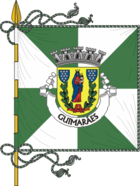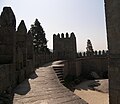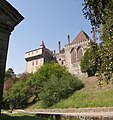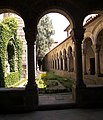Guimarães
| Guimarães | ||||||
|---|---|---|---|---|---|---|
|
||||||
| Basic data | ||||||
| Region : | Norte | |||||
| Sub-region : | Ave | |||||
| District : | Braga | |||||
| Concelho : | Guimarães | |||||
| Coordinates : | 41 ° 27 ′ N , 8 ° 18 ′ W | |||||
| Residents: | 158,088 (as of June 30, 2011) | |||||
| Surface: | 240.93 km² (as of January 1, 2010) | |||||
| Population density : | 656 inhabitants per km² | |||||
| Postal code : | 48xx | |||||
| Guimarães county | ||||||
|
||||||
| Residents: | 158,088 (as of June 30, 2011) | |||||
| Surface: | 240.93 km² (as of January 1, 2010) | |||||
| Population density : | 656 inhabitants per km² | |||||
| Number of municipalities : | 48 | |||||
| administration | ||||||
| Administration address: | Câmara Municipal de Guimarães Largo Cónego José Maria Gomes 4800-419 Guimarães |
|||||
| President of the Câmara Municipal: | António Magalhães da Silva ( PS ) | |||||
| Website: | www.cm-guimaraes.pt | |||||
Guimarães [ gimɐ'ɾɐ̃ĩʃ ] is a city in the north of Portugal in the Braga district . Here to Alfonso I (Afonso Henriques) , the first king of Portugal, being born, it is why the first capital of the country was and is considered the "cradle of the nation."
Guimarães was European Capital of Culture in 2012 (together with Maribor ) . The historic center of Guimarães is part of the World Heritage of UNESCO .
city
geography
Guimarães is located at the foot of the Serra da Penha , about 45 km northeast of Porto and 20 km southeast of Braga on the national road 101.
history
A rich Galician countess named Mumadona Dias is said to have built a monastery castle ( Castelo de Vimaranes ) here around 960 . Henry of Burgundy probably gave the city its first town charter in 1096 , but the document has not been preserved. Henry of Burgundy made Guimarães the capital of his county Portuguale in 1096 and had a castle built around the protective tower of the monastery, in which his son Alfonso I (Afonso Henriques) was born (probably) around 1109. With the battle of São Mamede on June 24, 1128, the Portuguese Countess Theresia , the mother of Alfonso, who wanted to oust her son from the succession in favor of her lover, was ousted. In 1139, after defeating the Moors in the Battle of Ourique , Alfons was proclaimed King of Portugal and initially made Guimarães the first capital of the young empire. In 1143 Castile recognized Portuguese independence in the Treaty of Zamora ; in the same year the capital was moved to Coimbra .
In the 15th century, the dukes of Bragança resided in Guimarães . In 1853 the previous small town ( Vila ) Guimarães was elevated to a city ( Cidade ).
Population development
| Population of the city of Guimarães (1864–2001) | |||||||||
|---|---|---|---|---|---|---|---|---|---|
| 1864 | 1878 | 1890 | 1900 | 1911 | 1920 | 1930 | 1960 | 2001 | |
| 7,568 | 7,980 | 8,611 | 9,104 | 9,550 | 9,023 | 9,541 | 23,233 | 52,182 | |
Culture and sights
Guimarães was the Council of the European Union to the European Capital of Culture proclaimed 2012th Maribor in Slovenia was also the 2012 Capital of Culture.
Museums
In Guimarães there are mainly three museums of international cultural importance, the Museu Alberto Sampaio (sacred art), the Museu de Arte Primitiva Moderna (modern naive art) and the Museu da Socidedade Martins Sarmento .
Buildings
In terms of buildings and other sights, the historic old town, the Castelo and the churches Igreja do São Miguel do Castelo , Igreja Nossa Senhora da Oliveira and Igreja dos Santos Passos should be mentioned. The Paço dos Duques de Bragança and Palácio de Vila Flor palaces are also among the sights of Guimarães.
- Castelo: The old Romanesque castle was built in the middle of the 10th century on the orders of the Galician Countess Mumadona to protect the city and the monastery from the attacks of the Normans and Arabs . The son of Henry of Burgundy, who later became King Alfonso I , was born here in 1109. After the victory over the Arabs and the proclamation of the Kingdom of Portugal , an area between the Minho and Tejo rivers , he made Guimarães the first capital of Portugal in 1140. The keep ( Torre de Menagem ) has a height of 27 m. The castle complex is considered to be one of the best preserved Romanesque fortresses in Portugal. In the 1940s Salazar had the castle renovated. The enclosing walls are crenellated and tower-reinforced and enclose a relatively small triangular castle courtyard.
- The first Portuguese king Afonso I (Henriques) was baptized in 1111 in the nearby Capela São Miguel do Castelo from the beginning of the 12th century. Right at the entrance is a replica of the baptismal font, the original of which can be found today in the Igreja de Nossa Senhora da Oliveira . The sparse ornamentation and the only loopholes-sized windows create a somewhat gloomy impression. The many grave slabs that are embedded in the ground are worth seeing.
- Paço Ducal (Paço dos Duques de Bragança) : The palace was built around 1420 by Afonso H. based on the French model in the Norman-Burgundian style and is one of the most magnificent aristocratic residences of the 15th century. On the occasion of the millennium, Salazar had the building converted into an official state residence in 1960.
- The monument of Afonso Henriques was created in 1887 by the sculptor António Soares dos Reis and is not far from the ducal palace.
- The Largo do Brasil is one of the most beautiful places in the city. At its southeast end is the baroque Igreja dos Santos Passos from 1769.
- The Basílica de São Pedro , begun in 1737, is located on Largo do Toural.
- A multitude of alleys, shops and convents make up the lovingly restored old town . Probably the most beautiful and oldest street in the city, the Rua de Santa Maria , leads from the castle and palace ensemble to the central square, the Largo da Oliveira ("Olive Tree Square ").
- The most important building on the Largo da Oliveira is the Igreja de Nossa Senhora da Oliveira . The countess Mumadona Dias had the monastery built here around 960, which was expanded from 1387 to 1393. The most important prior of the monastery was the later Pope John XXI.
- The Museo Alberto Sampaio has been housed in the cloister and other parts of the church since 1928 . It houses important exhibits from churches in the region.
- The Alpendre is a square Manueline-Gothic portico. He has stood in front of the west portal of the church since 1342.
- The former town hall ( antigos paços do conselho ) from the 14th century, renovated at the end of the 17th century, faces the Igreja de Nossa Senhora da Oliveira .
Regular events
- Since 1906 the "Gualterianas" in honor of St. Gualter have been held in the first week of August. The festivities include Cortejo do Linho (linen festival) and the Batalha das Flores (flower battle). The festival ends with a big procession.
- From November 29th to December 7th, the students of Guimaraes celebrate the "Nicolinas" in honor of St. Nicholas of Mira. The "Ceias Nicolinas" are particularly popular: after dinner in one of the city's restaurants, the participants march through the streets and sing the "Toques Nicolinos" on their drums.
- Every year on December 13th, the feast of Santa Luzia is celebrated at the Capela de Santa Luzia in Rua Francisco Agra. Traditionally, a special pastry is made from rye flour and sugar, the shapes of which clearly have sexual connotations. Young men in love gave the phallus-like pastries to their loved ones; when the affection was returned, the girl gave a little bird.
- The "Romaria Grande de Sao Torcato" takes place annually in July in the municipality of Sao Torcato and is considered the largest Romaria in the Minho region. There is a four-day celebration, including the procession in honor of St. Torcato.
economy
In Guimarães the textile and shoe industries predominate.
traffic
Since 1884 Guimarães has been connected to the Portuguese railway network via the Linha de Guimarães to Porto. The route, originally built in meter gauge , was switched to the Iberian broad gauge and electrified in 2004, just in time for the 2004 European Football Championship games in Guimarães . Since then, in addition to the Urbanos do Porto suburban trains, there have also been a pair of Intercidades trains to Lisbon .
Sports
In the Dom Afonso Henriques stadium of the Vitória Guimarães football club with 30,000 seats, some games of the 2004 European football championship were held.
Twin cities
Guimarães has the following ten city partnerships and two collaborations:
| city | country | since | Type |
|---|---|---|---|
|
Brive-la-Gaillarde |
|
1993 | Twin town |
| Colonia del Sacramento |
|
2001 | Twin town |
|
Compiègne |
|
2006 | Twin town |
|
Dijon |
|
2016 | Twin town |
|
Igualada |
|
1995 | Twin town |
|
Kaiserslautern |
|
2000 | Twin town |
|
Kavadarci |
|
2006 | cooperation |
|
Londrina |
|
1987 | Twin town |
| Mé-Zóchi |
|
1989 | Parish partnership |
|
Montluçon |
|
2016 | Twin town |
| Ribeira Grande de Santiago |
|
2007 | Parish partnership |
|
Rio de Janeiro |
|
1999 | Twin town |
|
Tacoronte |
|
1997 | Twin town |
|
Tourcoing |
|
1997 | cooperation |
sons and daughters of the town
- Alfonso I the Conqueror (1109–1185), first king of Portugal
- Gil Vicente (1465-1536), playwright
- Emídio Guerreiro (1899–2005), freedom fighter and anti-fascist
- Guilherme de Faria (1907-1929), poet
- Manuel Monteiro de Castro (* 1938), Vatican diplomat and cardinal to the Curia
- José de Guimarães (* 1939), visual artist
- Luís Marques Mendes (* 1957), lawyer and politician
- Aurora Cunha (* 1959), track and field athlete
- Dionísio Castro (* 1963), athlete
- Domingos Castro (* 1963), athlete
- Joaquim Sampaio (* 1970), racing cyclist
- Ricardo Fernandes (* 1978), football player
- Fernando Meira (* 1978), football player
- Alexandre Martins Costa (* 1979), football player
- Pedro Mendes (* 1979), football player
- César Peixoto (* 1980), football player
- Ana Dulce Félix (* 1982), athlete
- Custódio (born 1983), football player
- José Mendes (* 1985), racing cyclist
- Vieirinha (* 1986), football player
- Vítor Tiago de Freitas (* 1986), football player
- João Sousa (* 1989), tennis player
- André Preto (* 1993), soccer goalkeeper
- Rui Sousa Martins da Silva (* 1993), handball player
- André Almeida (* 2000), football player
circle
administration
Guimarães is the seat of the district of the same name ( concelho ) . The neighboring areas are (starting clockwise in the north) Póvoa de Lanhoso , Fafe , Felgueiras , Vizela , Lousada , Santo Tirso , Vila Nova de Famalicão and Braga .
With the regional reform in September 2013, several municipalities were merged into new municipalities, so that the number of municipalities decreased from 69 to 50.
The following municipalities ( Freguesias ) are in the Guimarães district:
| local community | Population (2011) |
Area km² |
Density of population / km² |
LAU code |
|---|---|---|---|---|
| Abação e Gémeos | 2,694 | 6.73 | 400 | 030875 |
| Airão Santa Maria, Airão São João e Vermil | 3,657 | 7.48 | 489 | 030876 |
| Aldão | 1,293 | 1.55 | 833 | 030801 |
| Arosa e Castelões | 809 | 5.52 | 146 | 030877 |
| Atães e Rendufe | 2,630 | 12.09 | 218 | 030878 |
| Azurém | 8,348 | 2.90 | 2,879 | 030804 |
| Barco | 1,510 | 3.02 | 501 | 030806 |
| Briteiros Santo Estêvão e Donim | 2,089 | 5.94 | 352 | 030879 |
| Briteiros São Salvador e Briteiros Santa Leocádia | 1,799 | 9.39 | 192 | 030880 |
| Brito | 4,939 | 5.90 | 837 | 030807 |
| Caldelas | 5,723 | 2.69 | 2.125 | 030808 |
| Candoso São Tiago e Mascotelos | 3,794 | 3.86 | 983 | 030881 |
| Conde e Gandarela | 2,452 | 3.64 | 673 | 030882 |
| Costa | 5,155 | 4.71 | 1,094 | 030812 |
| Creixomil | 9,641 | 3.01 | 3,206 | 030813 |
| Fermentões | 5,707 | 3.76 | 1,520 | 030815 |
| Gonça | 1,051 | 7.03 | 150 | 030820 |
| Gondar | 2,837 | 2.51 | 1,131 | 030821 |
| Guardizela | 2,474 | 3.98 | 622 | 030823 |
| Infantas | 1,764 | 6.49 | 272 | 030824 |
| Leitões, Oleiros e Figueiredo | 1,466 | 8.98 | 163 | 030883 |
| Longos | 1,372 | 7.24 | 190 | 030827 |
| Lordelo | 4,287 | 4.97 | 862 | 030828 |
| Mesão Frio | 4.173 | 4.13 | 1.010 | 030830 |
| Moreira de Cónegos | 4,853 | 4.72 | 1,027 | 030831 |
| Nespereira | 2,578 | 3.69 | 699 | 030832 |
| Oliveira, São Paio e São Sebastião | 8,137 | 1.55 | 5,233 | 030884 |
| Pencelo | 1,258 | 2.40 | 525 | 030835 |
| Pinheiro | 1,234 | 1.93 | 638 | 030836 |
| Polvoreira | 3,495 | 3.29 | 1,061 | 030837 |
| Ponte | 6,610 | 6.01 | 1,100 | 030838 |
| Prazins Santo Tirso e Corvite | 1,876 | 4.59 | 409 | 030885 |
| Ronfe | 4,462 | 5.02 | 889 | 030840 |
| Sands of São Lourenço e Balazar | 1,537 | 6.46 | 238 | 030886 |
| Sands of Vila Nova e Sands of São Clemente | 3,434 | 7.25 | 473 | 030887 |
| Santa Eufémia de Prazins | 1,221 | 2.23 | 546 | 030842 |
| São Cristóvão de Selho | 2,357 | 2.66 | 885 | 030850 |
| Sao Jorge de Selho | 5,729 | 5.20 | 1.101 | 030854 |
| Sao Martinho de Candoso | 1,340 | 2.21 | 607 | 030857 |
| Sao Martinho de Sande | 2,533 | 3.30 | 767 | 030858 |
| São Torcato | 3,373 | 10.39 | 325 | 030865 |
| Selho São Lourenço e Gominhães | 2,293 | 4.15 | 552 | 030888 |
| Serzedo e Calvos | 2,284 | 4.50 | 507 | 030889 |
| Serzedo | 3,630 | 5.14 | 706 | 030866 |
| Silvares | 2,282 | 4.49 | 508 | 030868 |
| Souto Santa Maria, Souto São Salvador e Gondomar | 2,096 | 13.87 | 151 | 030890 |
| Tabuadelo e São Faustino | 2,553 | 5.05 | 506 | 030891 |
| Urgezes | 5,259 | 3.31 | 1,587 | 030871 |
| Guimarães county | 158.088 | 240.93 | 656 | 0308 |
Population development
| Population in Guimarães County (1801–2011) | ||||||||||||||||||
|---|---|---|---|---|---|---|---|---|---|---|---|---|---|---|---|---|---|---|
| 1801 | 1849 | 1864 | 1878 | 1890 | 1900 | 1911 | 1920 | 1930 | 1940 | 1950 | 1960 | 1970 | 1981 | 1991 | 2001 | 2004 | 2008 | 2011 |
| 47,465 | 46,619 | 44,188 | 46,277 | 49,738 | 54,910 | 58,997 | 56,359 | 65,417 | 82.120 | 97.064 | 116.272 | 121,145 | 146,959 | 157,589 | 159,576 | 161,876 | 162,636 | 158.124 |
Municipal holiday
- June 24th
Web links
- Official website of the city (Portuguese)
- Homepage of the European Capital of Culture 2012 Guimarães (English version)
- Info page in German
Individual evidence
- ↑ a b www.ine.pt - indicator resident population by place of residence and sex; Decennial in the database of the Instituto Nacional de Estatística
- ↑ a b Overview of code assignments from Freguesias on epp.eurostat.ec.europa.eu
- ↑ a b c Melanie Preisner, Bianca Dost, Lena Förster: Guimarães. Portuguese cultures of remembrance, TU Chemnitz, accessed on October 6, 2013.
- ^ Regis St. Louis, Robert Landon: Lonely Planet Portugal . Lonely Planet, 2007, ISBN 978-1-74059-918-4 , pp. 404 ( limited preview in Google Book Search).
- ↑ tagesschau.de : Guimarães and Maribor will become cultural capitals
- ^ Cidades ǀ Câmara Municipal de Guimarães. Retrieved August 17, 2019 .
- ↑ Guimarães website ( Memento of the original from November 27, 2007 in the Internet Archive ) Info: The archive link was automatically inserted and has not yet been checked. Please check the original and archive link according to the instructions and then remove this notice.
- ^ Publication of the administrative reorganization in the Diário da República gazette of January 28, 2013, accessed on March 16, 2014





















